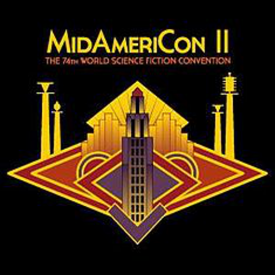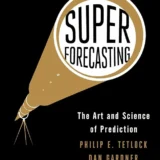Fanzines reviewed: THE FANTASY FAN (#1 & #2), published 1933.
Sorry, no pictures this time, but instead a PROLONGED BLAST FROM THE DISTANT PAST.
(Ed. Note: no small amount of research on the net has yelt a number of example issue images of some of the historical zines discussed here.)
The First Fanzine
Fan historians still argue over which fanzine was first. (Of course, they argue about everything, but that’s beside the point.) Some say “The Comet,” edited first by Ray Palmer (later a very famous and controversial professional editor indeed), published in May of 1930 by the “Science Correspondence Club.” This was an organization of fans who were entirely devoted to the furtherance of science. Consequently there was nothing fannish within the pages of their zine, just articles with titles like “The Psychology of Anger” and “Recent developments in television.”
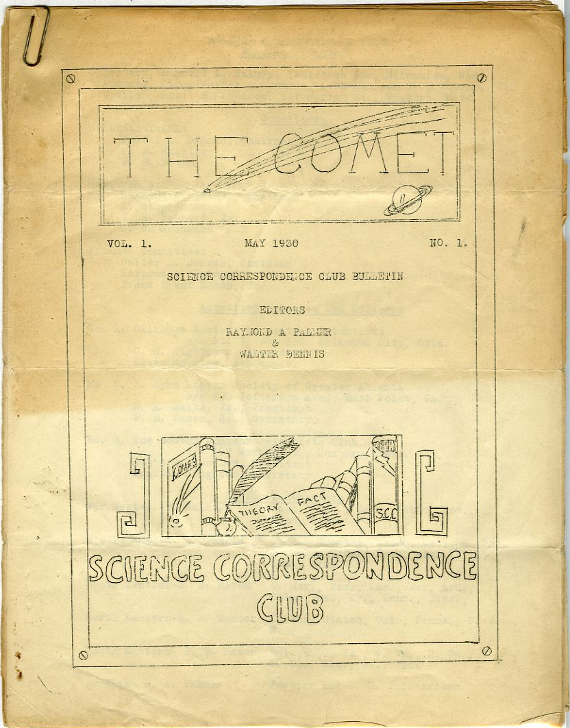
Others point to “The Planet,” edited by Allen Glasser, put out by the first true SF club “The Scienceers,” founded by James Fitzgerald, an Afro-American, who served as the club’s first President. Member’s meetings were held in his house in Harlem beginning in 1930. The first issue of “The Planet” came out in July of 1930. It was very fannish, consisting of reviews of SF&F books, magazines and films, along with articles about fandom itself. Sam Moskowitz, an extremely prominent fan of the era, considered “The Planet” to be the first true fanzine.
Most fan historians insist, however, that “The Time Traveller,” an independent zine aimed at promoting fandom in general, started up in January of 1932 by Allan Glasser, Julius Schwartz, and Mortimer Weisinger, was in fact the first fanzine. Unfortunately it didn’t last long, due to a falling out over Glasser’s alleged plagiarism in his professional writings. “The Time Traveller” is reputed to have achieved very high standards of writing and production value while it lasted, and was very popular with fans.
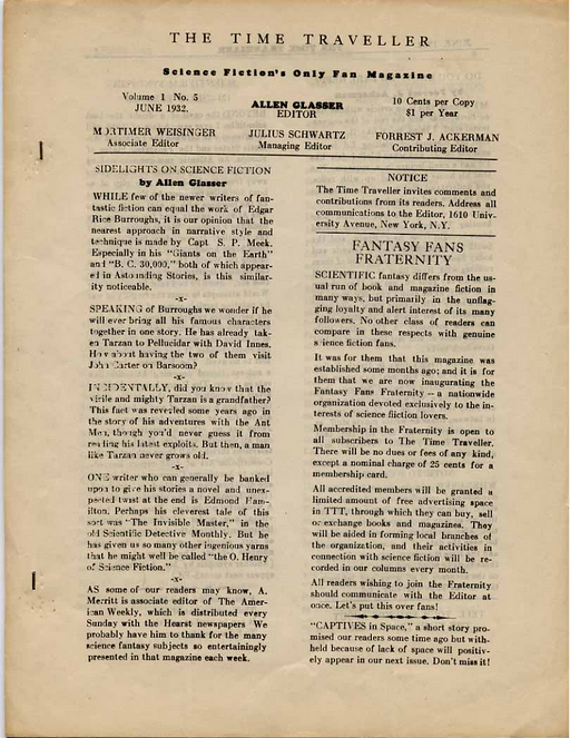
Schwartz and Weisinger, along with Forrest J Ackerman, Conrad Ruppert, and Maurice Z. Ingher, put in equal shares of cash to begin production of “Science Fiction Digest” in September of 1932. It ultimately achieved the reputation of quality which “has never been surpassed in the history of fandom,” according to a comment by Sam Moskowitz written circa 1945.

It set the standard, what with regular columns like:
“The Science Fiction Eye,” by Julius Unger, on the subject of publications worth collecting,
“The Ether Vibrates,” by Mortimer Weisinger, devoted to gossip both pro and fannish,
“Spilling the Atoms,” by Ray Palmer, likewise on gossip,
“The Scientifilms,” by Forrest J Ackerman, on recent fantastic movies,
and “The Science Fiction Scrapbook,” by Julius Schwartz, which reviewed recent books.
And then there are the three serialized tales “The Challenge from Beyond,” “the Great Illustration,” and “Cosmos,” which were written by multiple authors in collaboration including A. Merrit, H.P. Lovecraft, Clark Ashton Smith, Dr. David H. Keller, C.L. Moore, Donald Wandrei, Dr. E.E. Smith, Otis Adelbert Kline, Murray Leinster, Stanley Weinbaum, and Robert Howard, to name just a few of the more famous ones.
Perhaps it is fair to say that “Science Fiction Digest” was the most fantastic of early fanzines.
As for the “first” fanzine? I tend to agree with Sam Moskowitz and opt for “The Planet.”
The Fantasy Fan (#1) – September 1933 – Find here
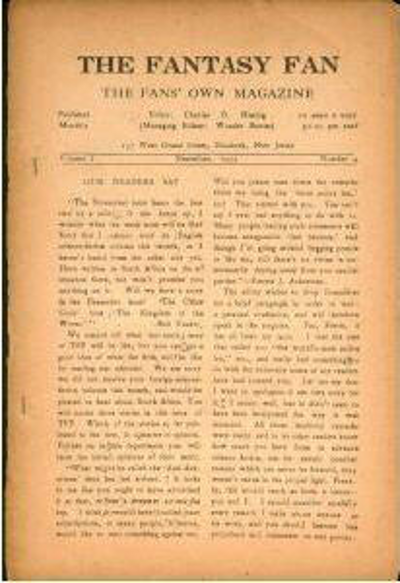
Faned: Charles D. Hornig. American Genzine.
Hornig was at great pains to point out in his early promotion for “The Fantasy Fan” that it was not in competition with “Science Fiction Digest.” The truth is, in the first issue at least, the two zines were remarkably similar.
In his editorial he stated: “The sole purpose of “The Fantasy Fan” is to strengthen the bond between the fans, and advance the popularity of fantasy fiction in every way possible. We will do our part by publishing interesting and absorbing articles by the leading fan writers and authors of the day—many dozens of which we now have on hand; occasionally an exceptionally good short story; poetry, and all sorts of regular monthly departments.”
One of the virtues of this zine, at least in the first issue, is that the articles in question tended to be very short, only a few paragraphs long, which greatly aided readability.
Among many articles within were:
A cash contest offering a dollar to the best response (100 words or less) to the question “Why do you read science fiction?”
“Conglamitorial,” by Ray Palmer, offering tidbits of gossip like “Drury D. Sharp’s first story, ‘The Goddess of the Painted Priests,’ in the April, 1929 Weird [Tales], was the only one where his first name was spelled out…”
“How to Collect Fantasy Fiction,” by Julius Schwartz. “It is a peculiar, but nevertheless well-founded fact, that there is something magnetic in fantastic fiction that will attract the reader as no other type of fiction can.”
“Club News” in which Forrest J Ackerman, a recently joined member of BSFA (the British Science Fiction Club) reveals that the famed Psychologist C. G. Jung was an honorary member of that club. One wonders whether Jung knew this.
“My Favorite Science Fiction Story,” by Mortimer Weisinger. It turns out to be “The Second deluge” by Garret P. Serviss whom Mort describes as “a world famous scientist.” Seems Mort has reread it so many times “that the characters in this tale seem like real people.” Always a good thing in fiction.
“Science Fiction English Magazines” by Bob Tucker. This is his first article published in a fanzine. He later went on to become one of the longest-lived and most beloved legendary fans of all time. In this article he describes stories appearing in “Wizard Magazine”, “Boy’s Stories,” “The Skipper,” and “The Rover.” He makes the statement “In no case is the author’s name given in the magazines. Evidently they believe in playing safe, because there ARE copyright laws in that country!” Here I believe he is referring to widespread plagiarism of stories from American zines, of which he gives one example. I hardly know what to make of this.
Most controversial of all, Forrest J Ackerman is the first guest author for “The Boiling Point,” a column reserved for hard-hitting accusations and opinions. Forry certainly fits the bill. He attacks Clark Ashton Smith for daring to submit a fantasy story to a science fiction magazine, and worse, getting it accepted and published.
The story under assault was “Dweller in the Martian Depths” which was published in a recent issue of “Wonder Stories.” Ackerman writes:
“It disappointed me very greatly to find it in a stf publication. In ‘Weird Tales,’ all right. I don’t like that story, I wouldn’t read it there. I fail to find anything worth-while in an endless procession of ethereal lights, phantastic visions, ultra-mundane life, exotic paradises, airy vegetation, whispering flutes, ghastly plants, and dirge-like horrors. May the ink dry up from the pen from which they flow!”
Them be fighting words! A response swiftly came for the second issue.
Incidentally, in this issue Hornig pays tribute to “The Time Traveller” as the first fanzine. This probably helped cement its reputation as such in the minds of contemporary fandom.
The Fantasy Fan Gets Hornig a Job!
This is truly amazing, and quite true. Seems Hugo Gernsback, who founded “Amazing Stories,” the first Science Fiction Prozine, over which he lost control in 1929, had rebounded by 1933 with four other zines, including “Wonder Stories.” However its editor, David Lasser, unexpectedly quit. To quote Sam Moskowitz:
“In dire need of someone to fill the vacant post, Gernsback cast about for a competent editor. His eye caught the title of a pamphlet on his desk—The Fantasy Fan. He glanced through it, at first casually and then with studied interest. A short time later, on the strength of the impression gained from the first issue of this amateur publication, he hired its seventeen-year-old fan editor, Charles Derwin Hornig, to edit ‘Wonder Stories’!”
Absolutely incredible. What fantastic luck! Hornig edited “Wonder Stories” from November 1933 to April 1936. His most noted achievement was accepting Stanley G. Weinbaum’s “A Martian Odyssey” for publication in 1934.
The Fantasy Fan (#2) – October 1933 – Find here
In the previous issue Ackerman went to town against weird fiction. Bad timing.
H.P. Lovecraft sent in a letter of comment: “Vol. 1, No. 1, looks to me very much what the younger science fiction devotee wants. Later on it might be a good idea to use matter of interest to weird tale enthusiasts—articles on the classics of weird literature, and information concerning weird magazines.”
Editor Hornig jumped at this suggestion with alacrity. In his editorial he writes: “We have a new policy. Starting with this issue, we will present a story every month (maybe more than one) by Clark Ashton Smith, H. P. Lovecraft, August W. Derleth, and other top-notchers in the field of weird fiction… In ‘The Science Fiction Digest’ we have a fan magazine for those scientifictionally inclined, which also presents gems of this type story by Arthur LJ. Burks, Ray Palmer, and others. We feel that the weird fans should also have a magazine for themselves—hence ‘The Fantasy Fan.’”
So, something of a nightmare for Forry, who liked weird fiction not at all. “The Boiling Point” column this time is given over to those opposing Ackerman’s views.
From August W. Derleth; “[Ackerman] …while usually quite interesting, nevertheless has the unpleasant habit of trying to make everything over into his own imagine.”
From H. P. Lovecraft: “As for Ackerman’s ebullition, I fear he can be hardly taken seriously in matters involving the criticism of imaginative fiction. Smith’s story was really splendid, except for the cheap ending on which the editor of ‘Wonder Stories’ insisted. Ackerman once wrote me a letter with a very childish attack on my work—he evidently enjoys verbal pyrotechnics for their own sake and seems so callous to imaginative impressions.”
And from Ackerman’s ‘victim & target,’ Clark Ashton Smith: “Mr. Ackerman’s fervent and ebullient denunciation of my stories, followed by Editor Hornig’s invitation to join the melee, is not to be resisted.”
“I infer that Forrest J Ackerman considers horror, weirdness and unearthliness beyond the bounds of science or science fiction… let me recommend to Mr. Ackerman, and to others like him, a more scientifically open and receptive attitude of imagination. If Mr. Ackerman were transported to some alien world, I fear that he would find the reality far more incredible, bizarre, grotesque, fantastic, horrific, and impossible than any of my stories…”
“Of course, it is Forrest Ackerman’s privilege to dislike my stories, and to express his dislike whenever he chooses. I have merely tried to point out that he is in error when he condemns them as being inherently unsuitable for a scientifiction magazine.”
Flame wars nothing new, it seems.
To top things off, Hornig publishes the opening salvo of Lovecraft’s “Supernatural Horror in Literature” which begins “The oldest and strongest emotion of mankind is fear, and the oldest and strongest kind of fear is fear of the unknown. These facts few psychologists will dispute, and their admitted truth must establish for all time the genuineness and dignity of the weirdly horrible tale as a literary form. Against it are discharged all the shafts of a materialistic sophistication which clings to frequently felt emotions and external events, and a naively insipid idealism which deprecates the aesthetic motive and calls for a didactic literature to “uplift” the reader toward a suitable degree of smirking optimism.”
Lovecraft quite good at inserting the sharpened zinger, methinks.
Clark Ashton Smith contributes “The Kingdom of the Worm,” which features a rather nasty character: “…he came into a great audience-room, with a throne of gold and ebony set on a high dais, all of which was illumed by no other light than the glimmering of decay. And the throne was tenanted, not by any human lord or sultan, but a grey, prodigious creature, of height and bulk exceeding those of man, and having in all its over-swollen form the exact similitude of a charnel-worm… Sir John became aware the worm was scrutinizing him severely, with little eyes deep-folded in the obscene bloating of its face…”
I wonder if Frank Herbert ever read this? Seems a bit of a precursor to the half-Emperor, half-human giant worm in “God Emperor of Dune.” It’s a theory.
Plenty of other good stuff in the second issue. I particularly liked the comment “Some fan, after reading one of Jules Verne’s tales in ‘Amazing,’ wrote in claiming that he was a very promising author!”
I should like to note, by the way, for those unfamiliar with Forrest J. Ackerman, that he was consistently voted “Number One Fan” throughout the 1940s, and later went on, in the 1950s, to become both a literary agent and the Editor of “Famous Monsters of Filmland,” a still published zine which was the first to be entirely devoted genre films. He also became famous for allowing his fans to tour the “Ackermansion” and his fantastic collection of stuff most weekends throughout his life. Alas, he and his high school buddies Ray Bradbury and Ray Harryhausen are no longer with us.
I highly recommend reading “The Fantasy Fan.” It reveals the early days of fandom superbly well. Brings it to life. In fact it is a bit like stepping into a time machine. The overall cumulative effect of reading these issues is, however briefly, to enter into the mindset of the fans of the day back when everything to do with fandom was fresh and new and full of promise.
The Fantasy Fan (#3) – November 1933 – Find here
Just a quick observation. Bob Tucker became famous for his wry and observant alternate persona “Hoy Ping Pong.” Issue #3 contains his very first article under that name, titled “How to Write a STF Tale.” Here be some samples of his advice:
“…the heroine; she must be a small, slim blond, blue-eyed scientist’s daughter. That’s the big point in originality. Nobody has ever thought of her being a scientist’s daughter before.”
“The big surprise of your story is this: Your villain must desire the heroine for himself. That is something new to STF readers. And, of course, I would politely suggest that the hero would also want the girl. That would make a triangle out of it.”
“…the invaders from Mars arrive on the scene about this time, also desiring world conquest. It would be a nice point of originality here to have the villain throw in with the Martians.”
Tucker was into satire a couple of decades before it became all the rage among fandom due to the likes of Walt Willis. Ahead of his time, he was.
( Multiple issues of The Fantasy Fan here )
BY THE WAY:
You can find a fantastic collection of zines at: Efanzines
You can find yet more zines at: Fanac Fan History Project
You can find a quite good selection of Canadian zines at: Canadian SF Fanzine Archive
And check out my brand new website devoted to my OBIR Magazine, which is entirely devoted to reviews of Canadian Speculative Fiction. I do a daily blog for it. Expect something different. Found at OBIR Magazine

 Fanzines reviewed: THE FANTASY FAN (#1 & #2), published 1933.
Fanzines reviewed: THE FANTASY FAN (#1 & #2), published 1933.


